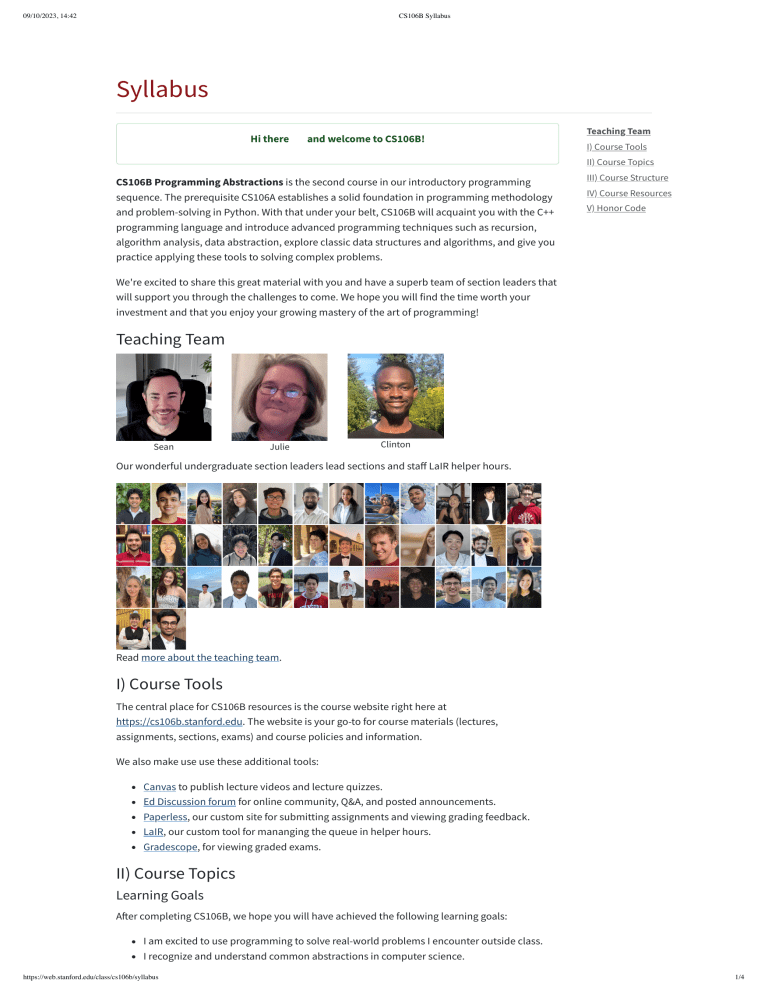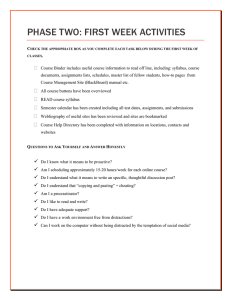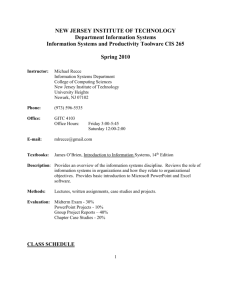
09/10/2023, 14:42 CS106B Syllabus Syllabus Hi there 👋 and welcome to CS106B! Teaching Team I) Course Tools II) Course Topics CS106B Programming Abstractions is the second course in our introductory programming sequence. The prerequisite CS106A establishes a solid foundation in programming methodology and problem-solving in Python. With that under your belt, CS106B will acquaint you with the C++ programming language and introduce advanced programming techniques such as recursion, algorithm analysis, data abstraction, explore classic data structures and algorithms, and give you practice applying these tools to solving complex problems. III) Course Structure IV) Course Resources V) Honor Code We're excited to share this great material with you and have a superb team of section leaders that will support you through the challenges to come. We hope you will find the time worth your investment and that you enjoy your growing mastery of the art of programming! Teaching Team Sean Julie Clinton Our wonderful undergraduate section leaders lead sections and staff LaIR helper hours. Read more about the teaching team. I) Course Tools The central place for CS106B resources is the course website right here at https://cs106b.stanford.edu. The website is your go-to for course materials (lectures, assignments, sections, exams) and course policies and information. We also make use use these additional tools: Canvas to publish lecture videos and lecture quizzes. Ed Discussion forum for online community, Q&A, and posted announcements. Paperless, our custom site for submitting assignments and viewing grading feedback. LaIR, our custom tool for mananging the queue in helper hours. Gradescope, for viewing graded exams. II) Course Topics Learning Goals After completing CS106B, we hope you will have achieved the following learning goals: I am excited to use programming to solve real-world problems I encounter outside class. I recognize and understand common abstractions in computer science. https://web.stanford.edu/class/cs106b/syllabus 1/4 09/10/2023, 14:42 CS106B Syllabus I can identify programmatic concepts present in everyday technologies because I understand how computers process and organize information. I can break down complex problems into smaller subproblems by applying my algorithmic reasoning and recursive problem-solving skills. I can evaluate design tradeoffs when creating data structures and algorithms or utilizing them to implement technological solutions. We’ll also be giving you tools to tackle the following questions (note that these don’t have single Teaching Team right or wrong answers!): I) Course Tools What is possible with technology and code? What isn’t possible? How can I use programming to solve problems that I otherwise would not be able to? What makes for a “good” algorithm or data structure? Why? Which problems should I solve with algorithms and data structures? What does a II) Course Topics III) Course Structure IV) Course Resources V) Honor Code responsible programmer do when using data about real people? Course Topics Our planned curriculum will cover the following topics in this approximate order: 1. C++ basics 2. Data abstraction, classic ADTs 3. Recursion and backtracking 4. Classes and object-oriented programming 5. Pointers and dynamic memory 6. Linked data structures 7. Advanced algorithms Prerequisites The prerequisite for CS106B is completion of CS106A and readiness to move on to advanced programming topics. A comparable introductory programming course or experience (including high school AP courses) is often a reasonable substitute for Stanford’s CS106A. If you are unsure if this course is the right for you, read more about course placement. III) Course Structure Lectures Lecture meets MWF 2:30 - 3:20 pm in Hewlett 200. Lecture recordings will be posted on Canvas for future review. All students are expected attend lectures in person if at all feasible (i.e., not if you are sick or an SCPD remote student), in order to fully participate in class discussions and other synchronous activities. We understand that this isn't possible for every student every time, so if you are unable to attend we ask that you at least watch the video of class before the next class, so you are up to speed on all course topics and important announcements. Read more about lectures. Note about recording consent: Video cameras are located in the back of the lecture room to capture the instructor presentation. These recordings might be reused in other Stanford courses, viewed by other Stanford students, faculty, or staff, or used for other education and research purposes. While the cameras are positioned with the intention of recording only the instructor, occasionally a part of your image or voice might be incidentally captured. If you have questions, please contact a member of the teaching team. Sections Each students is assigned to a weekly small group discussion section, led by an undergraduate section leader. Your section leader is your mentor, grader, and personal connection to the greater CS106B course staff. Sections begin the second week of classes, and attendance and participation are mandatory for all students. Your section leader will evaluate your section participation; this contributes to your course grade. Read more about section. https://web.stanford.edu/class/cs106b/syllabus 2/4 09/10/2023, 14:42 CS106B Syllabus Assignments There will be regular assignments, about one per week. An assignment may include written problems, hands-on exercises with the tools, coding tasks and/or a larger complete program. Assignments are to be completed individually. Programs are graded on "functionality" (is the program's behavior correct?) and "style" (is the code well-written and designed cleanly?). We use a bucket grading scale to focus attention on the qualitative rather than quantitative feedback. Read more about assignments, grading, and late policy. Teaching Team I) Course Tools II) Course Topics Exams III) Course Structure We have mid-quarter and end-quarter exams. The mid-quarter is a check-in to assess your IV) Course Resources understanding of core topics covered in the first half of the course and help you chart a path V) Honor Code forward. The final is a comprehensive assessment of your mastery of the course learning goals. Mark these dates in your calendar now! Midterm: 7-9pm Thursday November 2 Final: 8:30-11:30am Monday December 11 Read more about assessments. Course Grades Final grades for the course will be determined using the following weights: 55% Programming assignments 15% Mid-quarter exam 25% End-quarter final exam 5% Section participation In order to receive a passing grade in the course, you must earn a passing grade on the programming assignments as well as (collectively) the exams (i.e., failing an exam will not disqualify you from passing the course, as long as your average across both exams is a passing grade). So, someone who has a passing exam average but a failing average on the programming assignments, or vice versa, will not receive a passing grade in the course. Units If you are an undergraduate, you must enroll in CS106B for 5 units (this is by department and university policy, no exceptions). If you are a graduate student, you may enroll in CS106B for 3 or 4 units to reduce your units for administrative reasons. Taking the course for reduced units has no change on the course workload. Incompletes The university “I” grade (“incomplete”) is appropriate for circumstances of significant personal or family emergency disruption that prevent a student from finishing course requirements on schedule. To be considered for an incomplete, you must have completed all assignments at a passing level up at the point of your request for an incomplete. You must have an extenuating circumstance that warrants an extension of time beyond the end of the quarter to complete the remaining work. Approval for an incomplete is at the instructors’ discretion. Incompletes are not be considered for reasons such as poor performance in the course or over-commitment. IV) Course Resources Textbook Roberts, Eric. Programming Abstractions in C++. ISBN 978-0133454840. You can find different options to access the textbook here . Recommended readings for each lecture will be posted on our lecture schedule. Software The official CS106 programming environment is Qt Creator, which is an editor bundled with C++ compiler and libraries. The software runs on Windows, Mac, and Linux and is free for personal/student use. The Qt Installation Guide has instructions for installing the tools onto your computer. https://web.stanford.edu/class/cs106b/syllabus 3/4 09/10/2023, 14:42 CS106B Syllabus Getting help We want to enable everyone to succeed in this course and offer different paths to help. The instructors and Head TA will hold weekly office hours. The section leaders staff LaIR helper hours. The CS106B Ed Discussion forum allows public Q&A and discussion with your peers. Here is the Quick Start Guide to using Ed. Accommodations Students who need an academic accommodation based on the impact of a disability should initiate a request with the Office of Accessible Education. Professional staff will evaluate the request with required documentation, recommend reasonable accommodations, and prepare an Accommodation Letter dated in the current quarter. Students should contact the OAE as soon as possible since timely notice is needed to coordinate accommodations. The OAE has contact Teaching Team I) Course Tools II) Course Topics III) Course Structure IV) Course Resources V) Honor Code information on their web page: http://oae.stanford.edu. Once you obtain your OAE letter, please send it to the head TA. V) Honor Code As a student taking a Stanford course, you agree to abide by the Stanford Honor Code, and we expect you to read over and follow our specific CS106B Honor Code policy. The work you submit for grading must be your own original, independent effort and must not be based on, guided by, or jointly developed with the work of others. The CS department employs powerful automated plagiarism detection tools that compare assignment submissions with other submissions from the current and previous quarters, as well as related online resources. The tools also analyze your intermediate work, and we will run the tools on every assignment you submit. The vast majority of you are here to learn and will do honest work for an honest grade. We celebrate and honor your commitment. Because it’s important that all cases of academic dishonesty are identified for the sake of those playing by the rules, we will refer all cases of concern to the Office of Community Standards. All course materials © Stanford University 2023 Notice regarding uploading to websites: This content is protected and may not be shared, uploaded, or distributed. Website programming by Julie Zelenski • Styles adapted from Chris Piech • This page last updated 2023-Sep-26 https://web.stanford.edu/class/cs106b/syllabus 4/4


